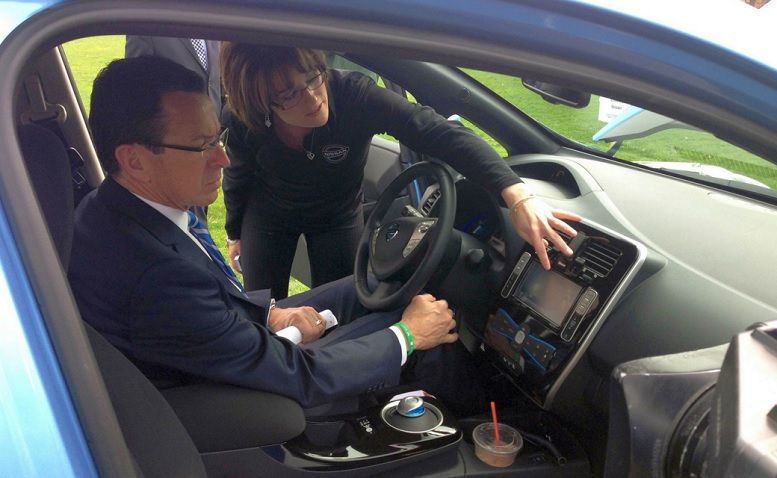Following the Paris Agreement negotiations last year, leaders from around the globe will meet Friday in New York to memorialize a commitment to limit global temperature rise to 2°C by 2100. Since the Paris Agreement is a national-level commitment, subnational governments have created the Under 2 MOU, where they commit to making drastic greenhouse gas emission reductions. In the United States, New York Governor Andrew Cuomo and Connecticut Governor Dannel Malloy joined seven other governors in signing the Under 2 MOU.
According to the EPA, transportation is the second largest source of ghg emissions in the country, comprising 27 percent of total emissions (electricity generation accounts for 31 percent of the nation’s emissions). In the tri-state region, however, transportation is the leading source of ghg emissions: 33.9 percent in New York, 46.3 percent in New Jersey, and 40 percent in Connecticut.
In order to make their commitments to the Under 2 MOU meaningful, the region’s leaders must go beyond providing incentives for driving electric cars. That means investing in public transportation and making low-impact, mixed-use, transit-oriented development not the exception, but the rule. This isn’t just Tri-State’s position; the EPA, the UNEP Risø Centre on Energy, Climate and Sustainable Development, the Intergovernmental Panel on Climate Change, and the Transportation Research Board all agree.
Despite this consensus, the three states in the region continue to invest in highway expansion while transit needs are deferred (or ignored) and wishful thinking about technological solutions from the future abounds:
- In New York, emission reduction objectives of downstate transit projects have been undermined by efforts to subsidize driving on the New York State Thruway.
- The Port Authority’s most recent capital plan only included about 10 percent for transit projects.
- In 2011, New Jersey Governor Chris Christie pulled out of the Regional Greenhouse Gas Initiative, and in 2010, he killed the Access to the Region’s Core rail tunnel project.
- In Connecticut, Governor Malloy has released a long-term transportation plan that includes billions for widening I-95 and I-84.
- New Jersey’s Transportation Trust Fund is staring down insolvency, which has led to higher NJ Transit fares and more bus and train commuters thinking about driving to work instead.
- When New York and Connecticut committed to the Under 2 MOU, the main focus was on renewable energy and electric vehicles, not transportation infrastructure or land use policy. This lack of attention to how people move and how communities are designed is mirrored in New York and Connecticut’s energy plans.
- Although New Jersey has not signed onto the Under 2 MOU, it also has an energy master plan. But it doesn’t mention public transit once, and is focused instead on emerging technologies and alternative energy vehicles.
If the region is going to play a part in helping the world meet its climate goals, we can’t wait for future technologies with undefined delivery dates — and we certainly can’t rely on things like LED lighting on 12-lane bridges to do the job. If we’re going to hit these targets, we simply cannot continue going about business as usual with the hope that something new will someday bail us out. We know how we created the problem, so we know how to fix it.
Support our fight for stronger transit networks and safer streets for biking and walking this Earth Day by making a contribution to our fundraising campaign.


[…] Tri-State: Investment in Transit, Not Electric Car Incentives, Will Help Region With Climate Goals […]
ghg emissions from transportation only 33.9% of total in NYS, 46.3% in NJ and 40% in CT! Aren’t we GREAT?
I wonder what it is in NYC alone; better, I’m sure.
BTW Are we counting emissions from air transport in these numbers? They do screw up the totals and are often excluded. Probably assigned to a 51st state–the atmosphere above.
[…] about building walls, installing air filtration devices, planting roadside vegetation, reducing tailpipe emissions, and planning future development away from the highway—impractical solutions for our most […]
To the author; a reminder, that ARC was a disaster in the making, a real money pit. Building a train to Macy’s Cellar would have only wasted money. I may despise Christie, but whatever his motivation, he was right. And he is right now to support the new project to build new NJT / Amtrak tunnels and tracks, which is what ARC should have been in the first place. I know, it sound better to belittle this horrific governor / VP candidate, but at least do it for the right reasons!
While calling on government to take corrective action is necessary, so is calling on corporate America. For example, Citizens Bank in Rhode Island has recently announced they are going to consolidate most of their office workers on a new “campus” on open space just west of our outer beltway I-295 which will require a new I-295 interchange, and an extension of sewer lines. The new interchange will spur even further sprawl in the region. There is no possibility of any meaningful transit service there, those without cars need not consider working there. In contrast, there are so many developed commercial spaces available, not just in downtown Providence but even in suburban districts like Warwick RI not far from the airport and easily accessible by train, bus, as well as I-95. But Citizens apparently doesn’t care about the environment, climate change, land use, or social justice. They are not alone, Fidelity Investments and others have done similar things in RI.
[…] imperative that national, state and local leaders realize that while transportation is only part of the problem at hand, there are tested (and […]
[…] time since 1979. It’s incumbent upon tri-state leaders to realize that if they want to be climate heroes, they can’t push projects or policies that facilitate […]
[…] commitment to the planet while also fulfilling his obligation to downstate transit users. As TSTC explained last year, […]